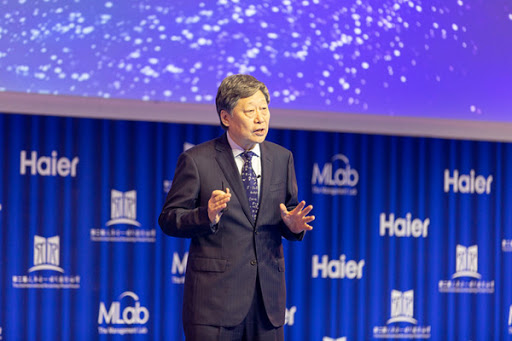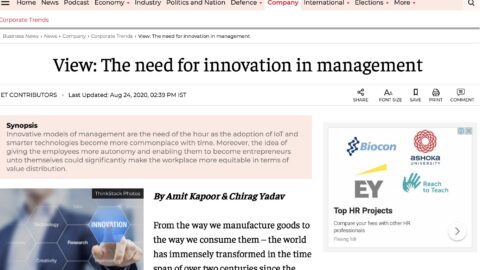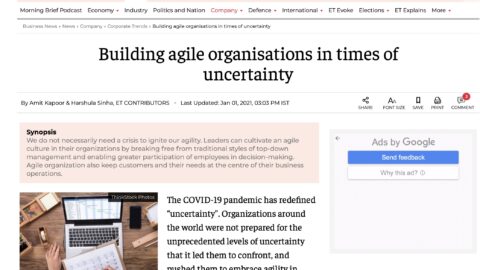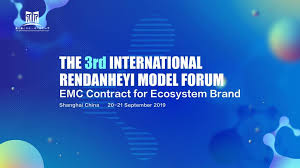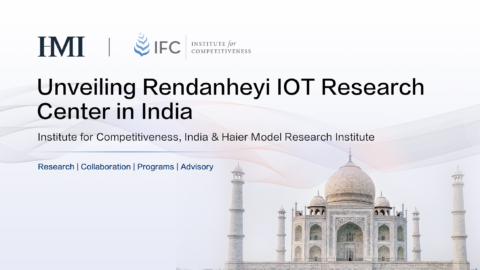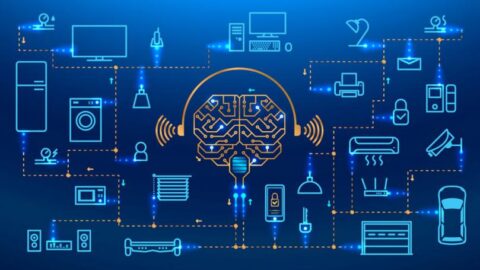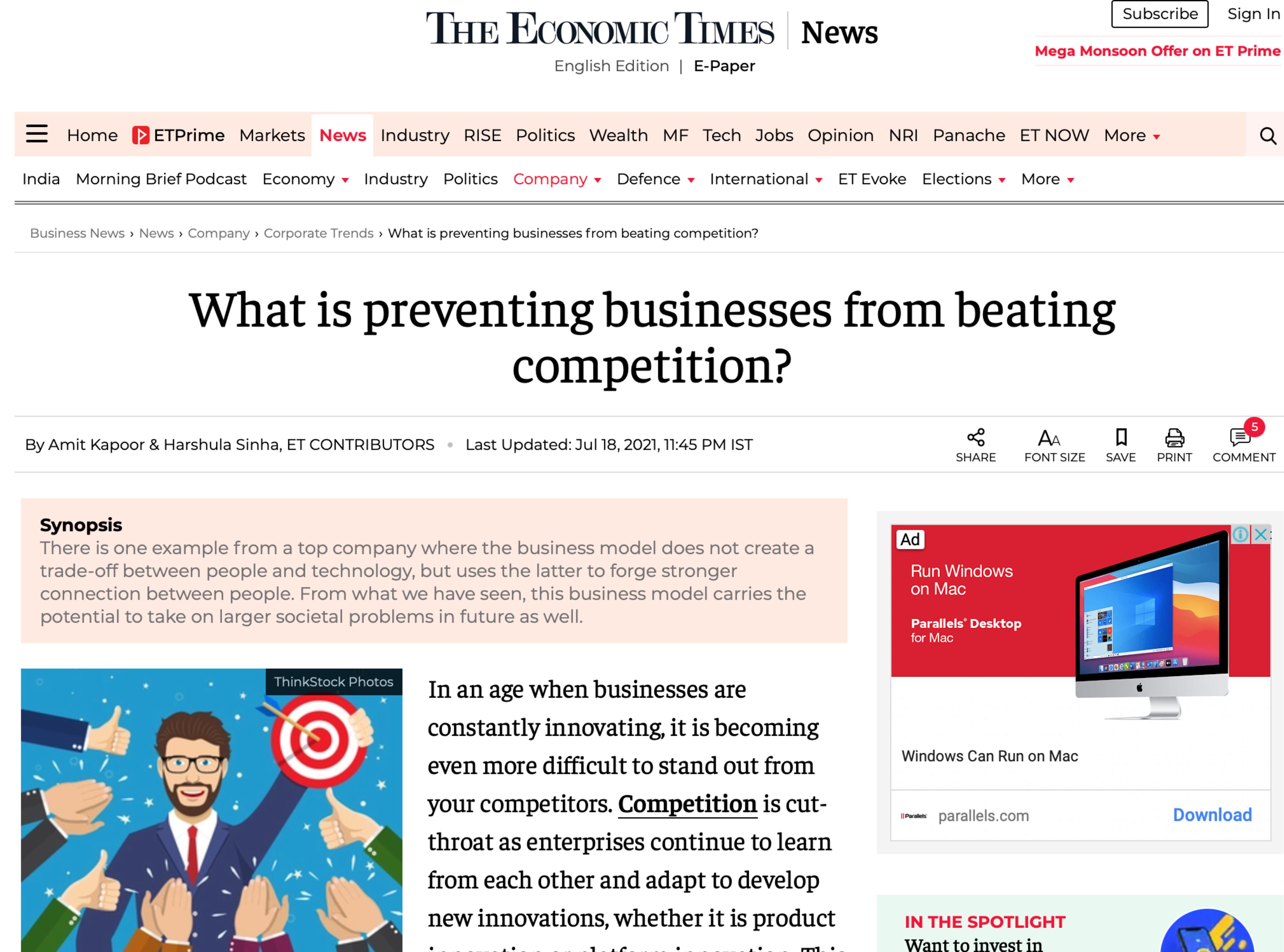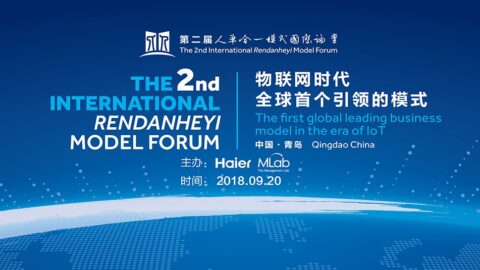On Sep 20th, 2017, the First International Rendanheyi Model Forum was held in Qingdao. It was a much-anticipated event in the business and management communities. Zhang Ruimin, CEO and Chairman of the Board of Directors of Haier, delivered a keynote speech in which he gave an in-depth analysis of the reasons, methods and purposes behind business model reinvention.
Zhang Ruimin: Rendanheyi – Building a Business Model for the Age of the IoT
It is my great honor to speak at this conference. Today we are joined here by many famous management experts and scholars from China and from around the world. In particular, we have some of the world’s leading management experts and scholars, such as Mr. Gary Hamel and Ms. Danah Zohar. We’re also joined by many entrepreneurs from the Haier community around the world. Although they are from different countries and cultural backgrounds, all of them have promoted the Rendanheyi model within their own cultural contexts. We’re also joined by friends from the media. I chose a very special tie for today’s event. On it you can see the word “thank you” written in several languages. This is exactly what I would like to say to all of you today. I am deeply humbled by your presence, and I want to say thank you to everyone here today.
My topic today is called “Rendanheyi – Building a Business Model for the Age of the IoT.” The age of the IOT has not yet fully arrived, and we’re not entirely sure what it will look like. But we should at least figure out the right business model for that age. I’m not saying that the Rendanheyi Model is definitely the right business model for the age of the IoT, but I believe that it has a couple of very important elements that will work for that age.
I believe IoT is the next major economic phenomena after mobile internet. The core idea behind the IoT is social economy, which means providing scenario-based services according to the needs of every person. This cannot be achieved by any of the previous business models. In Rendanheyi, “Ren” refers to employees or people, “Dan” refers to user needs, and “Heyi” means integrating employees and user needs. I believe these are the most basic and most necessary conditions for building a business model for the age of the IoT.
Let me explain the Rendanheyi Model by using the golden circle model by American writer Simone Sinek. You can see 3 circles here. From the center outward, they are labeled WHY, HOW and WHAT. Sinek believes that all ideas, including one’s life, start from the “WHY”. For example, why do I have to do this? What happens if I don’t do it?
So, why do we have to reinvent the current business model? Because we are living in a very different time. The business model must suit its time, and change as the external environment changes. The next circle is the “HOW”. We must design a path to carry out the reinvention of the traditional business model, and one important thing is to reinvent ourselves. It is very difficult to do away with an old model and establish a new one. The last circle is about the “WHAT”, or the goal. If we decided
to build a new business model, then we must make sure that this new model would be a leading model in the industry, and would bring about exponential growth. A half-way done reform isn’t much better than no reform at all.
1: Why reinvent? Because the changing of the times is a catalyst for new business models
Let me address this issue from 3 perspectives. First, why must we reinvent? Looking at history, we have gone through 3 different ages: the industrial revolution, the Internet age, and the IoT age. Different business reasonings and models were observed during different historical contexts, along with the different theoretical principles of different times.
During the era of the industrial revolution, the business model was centered on mass production and high efficiency production lines, with branding as a core element. If a company became a well-known brand during that time, then it would be able to see success in countries around the world; this company would also have the power of pricing, which would result in higher profit margins than their competitors. The guiding theoretical principles during that time was the Wealth of Nations by Adam Smith. In the first chapter, Smith talked about the division of labor: it would take a worker more than one day to produce a single clothes pin, but with division of labor, every worker could produce 4800 clothes pins a day. Adam Smith’s theory worked perfectly for his time. His book was published in 1776, and the world witnessed 3 major events that year: the start of the American War of Independence, the publication of the book The Wealth of Nations, and the mass production of the Watt steam engine, which was a benchmark event for the industrial revolution.
The next theory was that of scientific management by Frederick Taylor. Taylor’s book Scientific Management was published in 1911, in which he proposed the idea of transforming experience-based management to scientific management. One of the most important features of this theory is that it studied exactly how long it should take men to perform each given task. He went into great detail in examining various types of manual tasks. For example, he looked at workers shoveling ore and coal in factories, and identified the differences between these two types of works. Taylor’s work laid the foundation for Ford’s production line later on.
The third theoretical influence came from Alfred Chandler and his book Scale and Scope. Chandler studied the 3 major industrial countries, the US, Germany, and the UK, from 1870 to 1938. He believed that the greatest competitive advantage of these 3 countries was the amount of multinational companies they had. In his book he said that there are two pre-conditions for companies to become a “trust” or a monopoly: one is scale, and the other is scope, meaning companies must make more than one product. He also believed that a company’s development was based on two elements: strategy and organizational structure, and that the latter must adapt to the former. His theory is still influencing companies even today.
The end result of the industrial age was the utter destruction of low-efficiency
workshops by high-efficiency production lines. Today, many factories are still using the production line model.
The biggest difference between the age of the Internet and the industrial age lies in the business model, which has changed from that of mass production to bi-lateral or multi-lateral markets, and from centering around branding to centering around platforms. I believe that in traditional management ages, a company must either work hard on building its own brand, or it must work for another brand, if the company fails to establish a well-known brand of its own. In the age of the Internet, a company either owns a network or platform, or is owned by a network. Today, e-commerce players have monopoly on platforms, so all other companies must do transactions on their platforms, so in a way these companies are “owned” by the e-commerce players. The guiding theory for the age of the Internet is proposed by the French economist Jean Tirole, the 2014 Nobel Laureate in economics. He believes that the Internet industry is a bi-lateral market, which provides solutions when governments and markets both fail to function – sometimes both the “visible hand” and the “invisible hand” fail to function. In the past, the threshold for market entrance was too high, and it undermined the efficiency of the market. Many products never made it to market because they didn’t have name recognition or they didn’t have a large sales volume. Today the threshold is very low: disregard sales volumes and profit, and one can sell any product on an e-commerce platform. You can see the great difference. The result of the theories and practices of the Internet age is a non-linear bi-lateral market, which is a complete reinvention of the traditional unilateral market. In the past, manufacturing and sales were both unilateral, and companies could not predict weather a product would sell well. Things are very different today.
Now we are in the age of the IoT. I believe that the biggest difference between this age and the mobile Internet era is that we now have experience iterations based on scenarios and customization. In the age of the Internet, users choose the product that they want on e-commerce platforms; but today, companies are able to sense the users’ needs and deliver the right products spontaneously. The core of the business model today is no longer about brand or a platform, but lifelong users. It is predicted that the competitiveness of companies in the 21st century will be determined by its number of lifelong users. Having lifelong users means that the company is able to continuously meet the needs of its users, and this is very different from the age of the Internet. Of course, we have to overcome a lot of challenges before we can truly claim that we’ve entered the age of the IoT. The concept of IoT was proposed 18 years ago by MIT in 1999, but today we have not yet seen a true success of IoT. 2016 was considered the “beginning of the IoT age”, and people predicted that the real boom of IoT would be seen in 2019 or 2020. Why does Haier want to focus on IoT? Because we want to be the first one to lead in the IoT age with the Rendanheyi Model.
2: How do we reinvent? Through self-reinvention, we will build a most suitable business model for the paradigm of the IoT with the Rendanheyi Model.
I believe that the Rendanheyi model is the business model for the paradigm of the IoT. The concept of “paradigm” was proposed a long time ago by the American scholar Thomas Kuhn. Every age has a different business management paradigm, and paradigms from different times are not compatible with each other. I believe that the business model paradigm for the IoT will appear very soon, and it will replace traditional business models.
2.1: From Internet paradigm to IoT paradigm
Now that we are sure that there would be a business model for the IoT paradigm, how do we get there? If in the age of the Internet is the journey from 1 to N, then in the age of IoT the journey would be from N to 1. For the Internet age, the “N” refers to e-commerce platforms with numerous merchandises, and the “1” is each customer, who chooses the merchandise that they want on the e-commerce platform. In the IoT age, IoT is a small “n”, meaning the platform for social interaction, and “1” is the users; companies know what the users want and are able to satisfy them. These are the differences between the two paradigms.
Let me give you an example of one of Haier’s refrigerator micro-enterprises. They sell a type of refrigerator with a screen on its door, which connects the users with four hundred organic food suppliers. So, the product is not really the refrigerator itself, but a safe food solution. The users give us data while they use the refrigerator. I don’t quite like the concept of “big data”; I think companies must have customized “small data” from their users. For example, identify the number of users who have diabetes and deliver low-sugar foods to these users. On the e-commerce platform, customers usually buy a refrigerator and then pick low-sugar food themselves, but with Haier, a user with diabetes can have all his needs met through this refrigerator.
2.2: Haier’s exploration of IoT paradigms
The Rendanheyi business model is made up of 3 basic parts. The first part is the experience economy. IoT is an experience economy in the real sense, because all services are provided based on user experiences. The second part is the community economy. We have a platform called “Shunguang”, which combines 3 different types of stores: online, offline and Micro stores. We are all familiar with the idea of O2O – from online to offline. I have also heard about a book by an American professor called “Location is Still Everything”, in which he proposed the idea of O+O – online plus offline. In Haier, we combine 3 types of stores; so on top of O+O, we have added community Micro stores. With over 100 thousand Micro-stores, branching out into grassroots communities like the circulatory system of the human body.
The last part is an entrepreneur platform, and we call it the “entrepreneur economy”. As Professor Gary Hamel said just now, what works for today may not work when the times change. Everything we are doing with the entrepreneur economy is to make sure that regardless of how times change, we will be able to adapt accordingly. There are two main components of this platform. The first one is called
Haichuanghui, an entrepreneur platform we built that is open to all businesses both in China and abroad. You will find a wide range of industries and products on this platform, such as the drone that took our group picture this morning, as well as various Chinese Traditional Medicine companies. The other component is called FirstBuild, by GEA. It is very different from the Silicon Valley model, which is centered around grassroots entrepreneurship. FirstBuild is about entrepreneurship by existing large corporations. This is a very unique practice in the US. This March, I was invited to Stanford to give a speech on the Rendanheyi Model, and I talked about the Silicon Valley paradox: a lot of Silicon Valley start-ups were initially very innovative, but once they became large corporations, they couldn’t escape the traps of bureaucracy, and ended up moving further and further away from the market. HP is a good example: it became very slow after becoming a large company, and it grew further and further away from its users. So to sum up, FirstBuild, as a base for entrepreneurs, is very different from Silicon Valley; it is an entrepreneur base for large companies.
2.3: The constant rules of all business models
We are working on business models that are suitable for the IoT age, but still, these models must follow the 2 general rules of all business models: the rule of value proposition and the rule of value networks. Value proposition means creating user value; and value networks refers to transferring that value to users. In the age of traditional economies, companies had to build a good brand because it was all about your brand. Building a brand is valuable to the users, and even more valuable to companies. However, value transferring did not go beyond the manufacturers, who were able to obtain value based on the large volume they produce. When we work within the IoT economy now, we must still follow these two rules, but these rules look a lot different from before, because everything is based on networks. User value creation is based on networks, and value transfer is also done through a “value matrix”.
Let me give you an example: Haier makes more than 50% of the wine coolers in the Chinese market. On top of that, how much more value can we create in this industry? Not much more. But a wine cooler micro-enterprise of ours found a market pain point: restaurant customers usually bring their own wine, instead of ordering wine from the restaurant. Why is that? For one thing, customers worry that the wine provided by the restaurant may be a fake product. Also, customers believe that wine in restaurants is overpriced. Though customers are allowed to bring their own wine, restaurants are not happy about it, and so customers may not receive the best service possible. The wine cooler micro-enterprise provided free wine coolers to the restaurants, and reached out wine suppliers to supply the restaurants directly with bottles of wine; the restaurant would only pay for these bottles when they were sold. When customers arrive, they can select from a large variety of different wines. There are many advantages with this model. First, the customers now have a larger variety of wine to choose from, something they would never enjoy if they brought their own wine. Second, customers do not have to worry about the bottles in the cooler being knock-offs; third, the prices of the wine in the coolers are much cheaper than the market price, because there is no middle man in this model. At the end of day,
restaurants become a value matrix, where every player benefit from it. Customers are able to select better wine, and they do not have to go through the trouble of bringing their own wine; the restaurant can make a profit from selling wine; the wine-makers, although they supply the wine at a low price, still make money because there is no middleman. For Haier, although the wine cooler is provided free of charge, we still end up making more profit than we would have from selling the wine cooler itself. This is a value matrix where everyone benefits. I believe that the greatest change brought by the IoT age is a shared-platform. Without shared profits and interest, this business model is not sustainable.
2.3.1: Creating user value
First allow me to explain value-proposition both from a company perspective and as a mindset. There are 3 areas that need reinvention: companies, employees, and compensation. In terms of mindset, we must shift our value proposition and focus on creating user value.
In terms of companies, how do we change our mindset? Who defines a company? In the 1937 book “The Nature of the Firm” by Ronald Coase, he defined the purpose of companies as saving transaction costs (cooperation is directed by leadership), there would be no internal transaction cost between departments inside a company. Today, companies are nodes of the Internet, and they cannot close themselves off. If a company still believes that it can rely on itself and does not need the Internet, then there is no future for that company. Companies today have no choice but be a node in the Internet, where it can play a role, and create user value.
I would like to quote an important idea of Professor Danah Zohar: quantum entanglement. Professor Zohar proposed the concept of “quantum management”, and she believes that the 21st century is going to be the century of quantum management. Quantum entanglement, referred to by Einstein as “spooky action at a distance”, describes the phenomena when two quantum particles that are far away from each other can feel each other. One quantum can mirror the other one’s action and movement, as if they can sense each other. It’s just like when a person stands in front of a mirror, and his reflection does exactly what this person is doing. We need to incorporate quantum entanglement in our company, and this is what Rendanheyi is about. Whatever users are doing, employees must respond to these actions, just like how a reflection in a mirror would respond. This is quantum entanglement in a company.
Professor Zohar also mentioned 2 other conditions. The first condition is that every employee must become a “quantum self” – an independent person and also a person for others. This is not possible in traditional management models, where employees are just tools that carry out the orders of their executives; they are neither an independent person nor a person for others. The other condition is
“quantum leaders”, which is defined by Professor Danah Zohar as a leader that serves, or a “servant leader”. In Haier we removed over ten thousand people from middle management, and there are only 3 types of people left: “platform owners”, “micro-enterprise owners” and “makers”. A platform owner is different from a traditional leader, whose position is determined by the number of subordinates he has. A platform owner is evaluated by the amount of resources he provides to entrepreneurs, and how much contribution he makes to help micro-enterprises succeed. As Professor Hamel said, even I cannot tell the platform owners what to do, because my job is to serve them and provide support to them. This is a great reinvention for companies.
There are two types of employees in traditional companies, one is the “economy person”, and the other is the “society person”. During Frederick Taylor’s time, everyone was an economy person. After studying their work efficiency, the company create work-load plans for them. Employees are considered an economic resource, and work in order to make a living. People realized that this model was not good enough, because people need more than to just make a living, they also have social attributes, so the concept of the society person was adopted. I believe that both of these concepts are centered around the company, but now we want to develop a model that centers around the employees. So we created the idea of an “autonomous person”, to replace the “economy person” and the “society person”. People would be able to make real decisions for themselves by using three rights: 1) decision rights to make decisions for themselves, 2) human resource rights to hire whoever they see fit, 3) compensation rights, meaning that they can determine their own compensation. The precondition for all three rights is that the employees must create user value, or else they won’t be given any of these rights. So, employees become very independent.
In my conversation with 3 GEA managers two days ago, I said that there was a very important saying from the Declaration of Independence in 1776, that all men are created equal. But this is not true in large companies in the US. The CEO is the king and the dictator. But today everyone wants to be their own CEO. As Peter Drucker said, in the companies of the 21st century, everyone should become their own CEO. This means making decisions for yourself, realizing your value and having dignity.
The third right refers to compensation rights. There are two types of traditional compensation. The first type is position-based compensation, in which the salary is determined by the importance of the employee’s position and the employee’s capability. The second type is the principal-agent incentive mechanism, nicknamed the “golden handcuffs”. The stockholders promise the managers stock future options, but the managers must produce profit in return. Many Chinese companies have learned this model from US companies. In Haier, we adopted a “paid-by-user entrepreneur ownership”, in which all compensation is determined by the user-value created. Some of our micro-enterprises started a compensation mechanism called
“0030”. The first 0 means zero base salary – if no value is created, then the employees would have no salary at all. The second zero refers to zero expanse – meaning no extra funds for things like business trips. 30 means that when value is created – sometimes it could be a great amount of value – then 30% of the value created must be set aside as risk funds. So, in Haier’s model, everyone is an entrepreneur, and everyone’s compensation is linked to user value.
I believe that we have solved a big issue. Professor Oliver Hart was awarded the Nobel Prize in economics last year for his Incomplete Contract Theory. He said that the economic literature has created a sub-theory known as the principal-agent incentive mechanism, in which all people with stock options are bound by a complete contract, meaning that their contribution completely matches their future reward; but for most people, their relationship with the company is not a principal-agent incentive contract, and they cannot link residual income and residual rights of control together. So, other than those people who are promised stock options, everyone else is still rewarded with a fixed salary and bonuses. I believe that the Rendanheyi Model solves this issue. We turn our relationship with our employees into a complete contract, because everyone is an entrepreneur, and everyone’s compensation is directly linked to market performance. Everyone’s compensation is clear, and the number is determined beforehand. In summary, in order to turn the company’s value proposition into user value creation, the company must reinvent these three rights, and change their value system.
2.3.2: Value network: value transferring
Next, I would like to talk about value networks. I mentioned 3 platforms before: the connected factory platform COSMOPlat, the Shunguang Platform and the entrepreneur platform that is open to all businesses. Currently, there are two connected industrial platforms in the world, Germany’s Industrial 4.0, and AMP of the US. I believe Haier’s COSMOPlat is the third one. The connected factory of Haier is completely user centered. The theme of the 2017 Hannover Messe was “Integrated industry – creating value”; after seeing Haier’s user-centered connected factory concept, some German experts and companies believed that Haier’s user-centered connected factory may be even more fitting for that theme than Industrial 4.0.
Here’s a case example of a failed product from Volkswagen: the Volkswagen Phaeton. The company worked on this product for 14 years, and lost 2 billion euro. Last March, they officially stopped making this model. The Volkswagen Phaeton’s transparent factory used to be a paragon of Germen’s manufacturing industry, and all companies that visited Germany would go to that factory. But why did the Phaeton fail? Because there was no real user experience. First, the company should not have insisted on positioning this model as a high-end car. The company built their transparent factory and invited some user participation, such as having users join in the product roll-out ceremony. However, when users actually drove this car, they did
not feel that it was a high-end car. If you looked at the initial value chain and value matrix, you would see that the company was still following the value chain theory, proposed by American economist Michael Porter in 1985. According to this theory, the value chain chart of all companies looks like a giant arrow, and there are two lines: the first line represents basic activities such as human resources and finances; the second line is a series of activities such as production, supply and sales. The whole theory is about how companies realize value on these two lines and bring more customers. But in today’s world, the idea of the value chain should be replaced by the value matrix. The important thing about Volkswagen Phaeton is that their business model looked similar to Industrial 4.0, but its guiding principle was still smart manufacturing with a one-way value chain.
The Shunguang Platform integrates three types of stores, and it is a platform of co-creation and sharing. It is a touchpoint network. Customization is not possible without touchpoints. Haier’s touchpoints reach out to every community, and it is customization in the real sense. Many smart products today are faced with an awkward situation today: they received good reviews, but their sales figures were not great. I think one important reason is that companies that make smart products still have a binary value chain which features the relationship between the company and the customer, but today companies need to create a ternary relationship. The relationship between companies and customers have changed: companies provide resources, and their goal is not to satisfy customers, but to create users; companies are not just selling products, but also services. Going from a binary to a ternary relationship, the added element is the interaction with all users, and the customized solution from this interaction.
The last type of platform is the Haier entrepreneur platform, like Haichuanghui and FirstBulid, which are open to all businesses. The main purpose of these platforms is to look for new business opportunities, and start “the Second Curve”. Whatever business you are in, your growth curve will ultimately reach a peak, and then the growth will slow down. Do not wait until that moment to start thinking about solutions. You want to find the second curve before your growth curve peaks; this is the “second time entrepreneurship”. Also, in Haier we are not just making products; we also encourage entrepreneurs. If a company only focuses on making products, then it would be self-restricting; but if it encourages innovation, then the company would have potential for abundant products and new ideas. I also want to note that we are not looking for customers, but life-long users. Another critical point is that our goal is not just to be the No.1 in a particular area, but the only one in that area. Why is that? Because at the end of day, the No.1 may be surpassed by others, but the “only one” keeps reinventing, and creating new value in “no man’s land”.
3. The purpose of reinvention: making the Rendanheyi Model as the leading business model in the age of the IoT
3.1: The Rendanheyi Model is a global business model
The last point is the purpose of reinvention. First, Rendanheyi is a global business model. We have acquired many companies with the salad dressing model: the various types of vegetables in the salad represent different cultures or life styles of different countries, but they all share the same dressing – the Rendanheyi model. Let me give you an example. We acquired the Japanese company Sanyo, and one of their important cultural values is team spirit. We didn’t change their team spirit, but guided it with the Rendanheyi model. In the past, the team followed the managers or leaders. If the manager told the team to do something, then the team needed to stay up all night and do it. But now the team spirit must be connected with the users, and employees must listen to what users want.
The second example is the New Zealand company Fisher & Paykel. They have great manufacturing quality, and the people there have a spirit of craftsmanship. Before being acquired by Haier, Fisher & Paykel products were priced very high, and despite the sales volume being great, the company still faces losses in the end. Why was that? Because the company took pride in making exquisite products but did not pay enough attention to user experience. After the acquisition, we shifted the direction of the company and made sure it focused on users around the world. The company has been turned around and now is on a great path of development.
The third example is GEA, a company with over 120 years of history. The past three leaders of GEA had been working hard to make changes. I believe that changing GEA is very hard, because this company has a very clear management system, with every step laid out clearly, and employees are asked to follow these steps. But the greatest problem with their “spirit of honoring contracts” is its linear quality. Today, we need management to be non-linear. That’s why I would say that the new leadership styles have been very courageous. Within a short amount of time, they have already started to turn this 120-year old company into a micro-enterprise. This is no small task.
To sum up, I believe that the application of the Rendanheyi Model has been successful around the world, and this is because the model is centered around the value of people, and is dedicated to allowing people to realize their full potential.
3.2: The Rendanheyi Model works for all sectors in the society
Second, the Rendanheyi Model works for the entire society – not just for the manufacturing industry, but other sectors as well. For example, Haier Financial acquired Shanghai Yongci Rehabilitation Hospital, which used to be a public hospital that was on the verge of bankruptcy. Instead of injecting funds into the hospital, Haier introduced the Rendanheyi concept after acquisition, and created a model called “the integration of doctors and patients”. These days in China, there is a great tension between doctors and patients, but these two groups of people actually share
the same goal. This is what we did to transform the hospital’s old model into the “doctor and patient integration model”: in the past, patients had to go through various departments of the hospital in order to receive treatment; after the acquisition, we divided the hospital by floors, and all departments on one floor would be considered as a whole unit, which must be patient centered. After the transformation, patient satisfaction was great. Now there are more patients showing up than the hospital’s capacity. We also implemented this model in other hospitals, where we do not have any stock. We exported the Rendanheyi Model as a management model. These hospitals can also become online hospitals. The successful application of the Rendanheyi Model in the medical industry shows that this model can be applied to industries that are completely different from the manufacturing industry.
Haier Financial also invested in a beef cow industry ecosystem. Many players in this industry were not very successful, but Haier Financial did quite well. Instead of investing in one single beef cow company, they invested in the entire industry chain. Usually the price of beef was around 10 to 20 RMB, but Haier Financial was able to raise the price by 10 times that, because they worked with all players in this industry chain, including grass, breeding, cold chain and so on. Together they increased the value of their product. This industry chain is open for investment and can be shared, so it is now developing very well. In addition to the beef sector, Haier Financial has now invested in the egg industry, and they have a scale numbering in the billions of eggs. They are able to achieve these results because they integrated all of the players in the industry chain through the Rendanheyi Model, so everyone works together to create value.
3.3: The Rendanheyi Model is a model of the IoT time, with the “User Multiplier” concept as the touchstone
Finally, the theoretical basis for the Rendanheyi model is the “user multiplier” concept. There are 2 parts of this concept: ratio multiplier and value multiplier.
The “A” in the ratio multiplier is the customer ratio, “B” is the interactive user ratio, and “C” is the lifelong user ratio – these ideas are about conversion. First, when a product is launched, you want to secure the largest amount of customers possible and take the largest market share possible, possibly even 100% of the market share. Next, if you have 1 million customers, how do you convert these customers into interactive users? In the traditional economy, once the product is sold, the company has no relation with the customer afterwards. Today, however, companies must make sure that the customers will keep in touch, because companies are now selling services, and must iterate and continuously make changes based on user experiences. Only in this way would the company be able to convert customers into lifelong users. So here is the goal: convert all customers into interactive users, and then convert them into lifelong users. It is hard, but it can be done.
Next let’s talk about value multiplier. A refers to product value, B to interactive user value, and C is ecosystem value. We want the ecosystem value to be greater than the product value. Let’s look at the wine cooler example again: the ecosystem value of the wine cabinet in the hotel may exceed the value of the wine cooler itself. It is not so hard to imagine that, with enough ecosystem value, hardware in the future could be very inexpensive or even free.
As a result, we changed the format of our company’s financial statement. Traditional income statements are very straightforward: Operating income minus costs and expenses equals profit. We have replaced it with a “Win-win Value-added Statement”, which includes both hardware income and ecosystem value. We have sent this new statement model to the Institute of Management Accountants, who designed the traditional income statement. We asked for their opinion of the Win-win Value-added Statement, which we believe may be more suitable for the age of the IoT. They agreed that it was a good idea; they had been thinking about changing the traditional statement model as well, but hadn’t come up with a specific solution yet, and they liked Haier’s approach. Now, the Institution of Management Accounting, Haier and Tsinghua University are working together to develop such a statement.
Haier’s multiplier is calculated differently from traditional methods. There are two traditional models: the currency multiplier and the DuPont model. The currency multiplier is used in Keynesian economics, where it’s fine if there is no actual growth, because you can just put the money in an investment project and let it generate interest. For example, if you put 1 million dollars into the bank, the bank will loan out this money batch by batch. Considering the leakage ratio, a small amount of the 1 million dollars may not be able to generate interest, but the majority of this money can keep generating interest. With 1 million dollars, you may end up with 10 million dollars. So this is the currency multiplier: base currency generates more currency. However, the only thing changing here is the amount of money you have.
The other is the DuPont model, which was invented by the American company DuPont. One important point about this model is the way return on equity is calculated: net income after tax is divided by shareholder’s equity. This model is designed to create maximum stockholder profit. I think there are two problems with this model. First, it only considers shareholders, and does not consider users. But stockholders do not create value, but only take a share of the value. Why don’t we put users first? When I was making speeches in the US, I also said that I disagree with the shareholder first idea in American companies, and I believe that we should put users first; or at least put your employees first, and then afterward putting the users first. Without user value, how can there be long-term value for the shareholders? I think there wouldn’t be. The second problem with this model is that it is based on
marginal revenue. With traditional models, marginal revenue is always going down: the higher the sales volume is, the lower profit is for each item, because more companies would in turn make this product, and there would inevitably be a price war. This means marginal revenue would inevitably go down. But in the time of the IoT, an increasing marginal revenue is possible. Think about the wine cooler case I talked about earlier: we can even provide the hardware for free, because there is ecosystem revenue! In summary, our user multiplier is very different from traditional formulas.
I would like to quote one saying from Tao Te Ching by the ancient Chinese philosopher Laozi: “the greatest system is an integrated one”: it means that all good mechanisms are a complete system, and you cannot cut it into pieces, or else you would not be able to see the whole picture. I believe that this is the greatest difference between Chinese and western cultures. Chinese system theory of systems is very helpful to Chinese companies in today’s IoT time. The “Tao” proposed by Laozi 2000 years ago discusses the pattern of all changes in the universe. The pattern of the changes in the universe is itself a system theory. During the same historic time, about 400 BC, the ancient Greek philosopher Democritus proposed the atomic theory, believing that the nature of the universe are atoms. The Western civilization has been following the atomic theory, believing all things can be viewed from the perspective of atoms. For example, in the medical field, traditional Chinese medicine uses dialectical approaches, while western medicine takes the micro-level approach of looking at the cells. A good traditional Chinese doctor looks at a patient and knows what the underlying health problem of the patient is, while in Western medicine, doctors from many departments would have to gather together and look at one patient, because the western medicine adopts a fragmented approach, instead of an integrated one. The same thing can be said about management. If you invite a consulting firm to take a look at a company with management problems, the firm may find many reasons in many departments, for example, problems with the finance department, or the procurement department, or maybe all departments take some responsibility for the company’s problem. But what is the root cause? Maybe the consulting firm would not be able to find it at all. What Haier is doing today is that we are turning all departments into micro-enterprises; each micro-enterprise has all the functions, and they are able to realize a zero-distance interaction with the users. This solves the root problem of companies. I hope that with the help of traditional Chinese wisdom and philosophy from 2500 years ago, we will be able to lead the world in management models for the age of the IoT.
Thank you.

